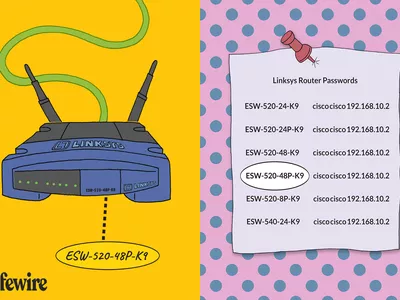
In 2024, How To Do Vivo G2 Screen Sharing | Dr.fone

How To Do Vivo G2 Screen Sharing
Smartphones by Vivo G2 are rich in functionality and offer multiple benefits to users. However, do we ever wonder about using screen share in Vivo G2 ?
Whether there is a need to show unique clicks or videos on a bigger screen or want to stream amazing content on big TVs or computers, we must know how to screen share on a Vivo G2 phone. It becomes a lot easier to cater to a big audience with big screens.
So today, let us go through a detailed guide on **how to screen share in Vivo G2 ** to smart TVs and computers.
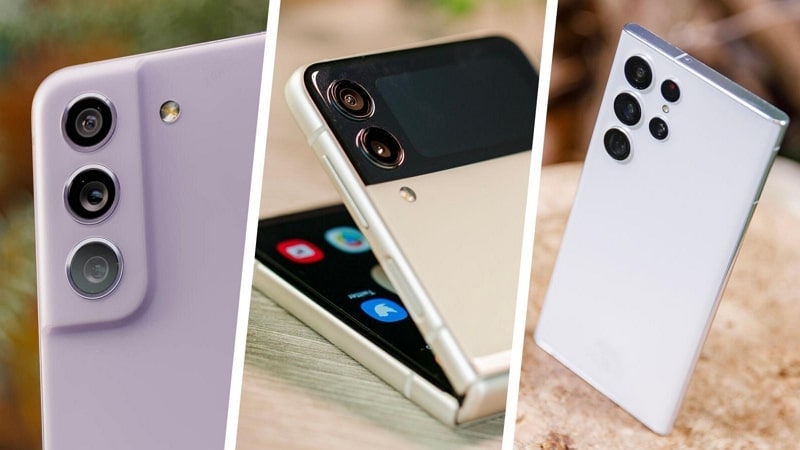
Part 1: Does Screen Sharing Use Bluetooth?
Bluetooth is not used for screen sharing as it does not have the bandwidth required to stream heavy media. Although it is commonly used for wireless data transfer, it is not suited for screen sharing. A major reason behind this is the slowness of Bluetooth, as its maximum speed for data sharing is up to 50MB/s. That makes it unreliable for screen sharing, making Wi-Fi the default choice.
Part 2: How to Share Screen From Vivo G2 Phone to Vivo TV Using Smart View?
Samsung Smart View is a feature in Vivo G2 devices that allows you to **screen share on Vivo G2 ** Smart TV. First introduced as an app, it is now an in-built feature of One UI.
When using the Smart View feature, you can share videos, photos, documents, games, and other things on your Vivo G2 device to your Vivo TV. The Smart View app allows you to use your Vivo G2 device as a virtual remote to control your Smart TV.
Requirements for Smart View App
The Vivo G2 Smart View app was introduced in 2011 to allow Vivo G2 users to share their device’s screen with Vivo TVs. Although it was discontinued on 05 October 2020 and replaced with Smart Things, its existing user base was not disturbed.
If they were already using the Smart View app or downloaded it before discontinuation, they can use it as long as they don’t uninstall it. These are the minimum requirements to use Smart View App on a device:
Android: It can be used on Android devices with Android OS 4.1 or above.
Samsung Smart TVs
All the Samsung Smart TVs after 2015 are compatible with Samsung Smart View. Below is the list of older Vivo TV models that offer Smart View compatibility for Samsung users:
- 2011 LED D7000 and above, PDP D8000 and above.
- 2012 LED ES7500 and above, PDP E8000 and above.
- 2013 LED F4500 and above (except F9000 and above), PDP F5500 and above.
- 2014 H4500, H5500 and above (except H6003/H6103/H6153/H6201/H6203).
- 2015 J4500, J5500 and above (except J6203).
- 2016 K4300, K5300 and above.
Samsung Devices with Smart View Feature
With the introduction of One UI in Samsung devices, the Smart View was added as an in-built feature. All Samsung devices launched with One UI can use the Smart View feature to share their device’s screen with Vivo TV. The Samsung devices that support the Smart View feature include Galaxy S Series, Galaxy Z Series, Galaxy Note Series, Galaxy A Series, Galaxy M Series, and Galaxy F Series.
Steps for Using Smart View to Share Screen
Before explaining the steps, it is important to state that available screens and settings may change depending on your device, Smart TV, or service provider. The Smart View feature is also unavailable on all Samsung devices, and you might need to use the Smart View or Smart Things app.
Ensure that your Samsung device and Smart TV are connected to the same network, and follow these steps for screen sharing:
Step 1: After connecting your device and Smart TV to the same Wi-Fi network, open the “Quick Panel” on your Samsung device. Here, press and enable “Smart View.”
Step 2: Select your Vivo TV among the available devices when Smart View is enabled. Once connected, choose the content you want to share on the TV screen.
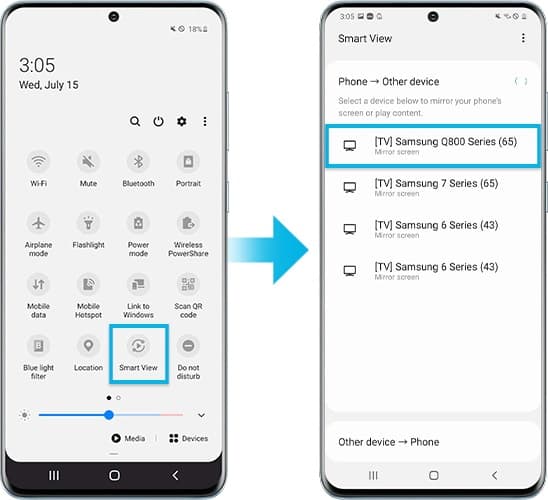
Step 3: You can select your desired content through options like My Photos, My Videos, or My Music. When the desired content is selected, you can enjoy it on a bigger screen.
Part 3: How to Share Screen From Samsung Phones to Other Smart TVs?
If your Smart TV is of another brand instead of Samsung, it is still possible to share the Samsung devices screen with your TV. Multiple tools are available online that can be used to share your Samsung device with your TV, depending on the TV brand. You can use tools like AllShare Cast, Chromecast, or Amazon Firestick.
Like Smart View, all wireless screen share tools require your Samsung device and Smart TV to be connected to the same network. Once connected, you will need to plug the respective tool’s adapter into your Smart TV, and you should be able to share your Samsung device. If your Smart TV doesn’t support Miracast, you can use AllShare Cast Wireless Hub for screen sharing.
Part 4. How to Share Screen From Samsung Phone to Computer Using Dr.Fone Air?
After learning about screen sharing to TVs, it is about sharing a Samsung phone screen with a computer. There is no need to worry, as we have a perfect wireless solution.
Dr.Fone Air is a powerful online screen mirror solution allowing screen sharing in Samsung to any computer. It can quickly mirror a Samsung phone to any web browser using a Wi-Fi connection only. Further, it is easy to download Wondershare Dr.Fone Air from its official website.
Key Features of Dr.Fone Air
- It provides great cross-platform support for screen sharing and casting. You can easily share screens from Android or iOS to Windows or Mac.
- You don’t need to give any unnecessary permissions when using Dr.Fone Air. It also doesn’t require Bluetooth or NFC for screen sharing.
- Your data during screen sharing remain protected as it doesn’t require downloading or uploading your content.
Steps of Using Dr.Fone Air for Screen Sharing
Sharing your Samsung phone screen with your Vivo TV using Dr.Fone Air is a simple and quick process. Your Samsung device and Vivo TV needs to be connected to the same Wi-Fi network. Once they are connected, follow these steps for screen sharing:
- Downloading and launching Dr.Fone Air: The first step is to download and launch Dr.Fone Air from the official website. The next step is to connect the Samsung phone and computer with the same Wi-Fi connection.
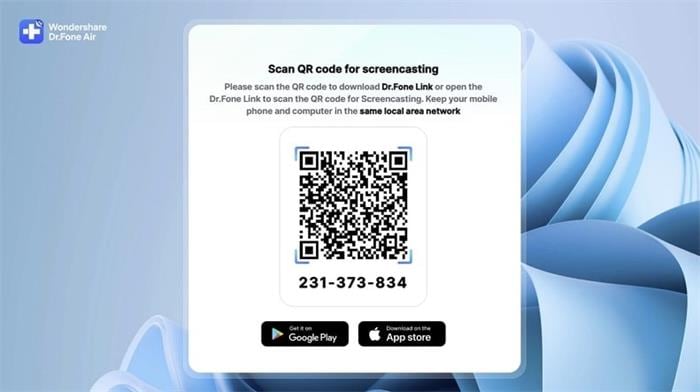
- Using QR or Cast code: The second step is to use the QR or Cast code as shown on the screen of the browser.
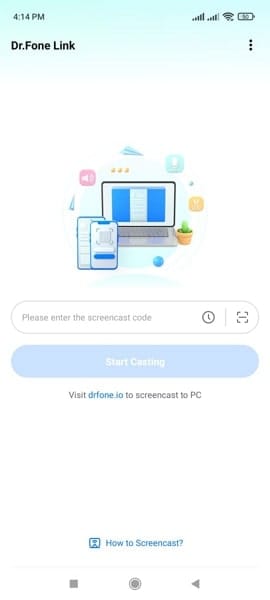
- Mirroring Samsung phone to computer: The Samsung phone will be automatically mirrored to the computer on successful scanning or code entering.

Conclusion
Hope everything is clear to our readers about the different methods to share the screen in Samsung. The detailed steps for screen sharing on Samsung phones to Vivo TVs and other Smart TVs make it easy for users to optimize the benefits of the big screen.
Make sure to check out is using Dr.Fone Air for sharing screens from Samsung phones to computers directly. It is a reliable, secure, and quick method to wirelessly mirror any mobile phone screen to any web browser.
Recommended Best Applications for Mirroring Your Vivo G2 Screen
Smartphones are much more advanced now, allowing users to stream types of content in high-definition easily. However, regardless of your phone type, the screen will seem too small for multiple people to see their content together. Using a mobile screen mirroring app can help there.
For example, you are watching a movie on your phone with friends, but no stand is available for phone rest, and the screen is too small. You can use a capable share screen app Android feature to mirror the screen on another device from a smartphone. Read to learn how.
Best Apps for Mirroring Screens in Android Smartphones
Before discussing the methods in detail, let us briefly look at the different types of mirroring methods you can trust in this regard.
| Mirror and Control | Easy of Use | Pricing | |
|---|---|---|---|
| Dr.Fone Air - Online Screen Mirror | Yes | High | Free |
| Screen Stream Mirroring | Yes | High | Free with in-app purchases |
| LetsView | Yes | Medium | Free |
| Pushbullet | Yes, with limitations | Medium | Free |
| Pro- USD 4.99 (monthly) or USD 39.99 (yearly) | |||
| TeamViewer | Yes, with limitations | Medium | Premium- USD 37.88/month |
| Corporate- USD 80.67/month | |||
| Vysor | Yes | High | Starts at USD 2.50 |
| AirDroid Cast | Yes | High | Free |
| Remote Casting- USD 2.49/month | |||
| Cast & Control- USD 3.49/month | |||
| Cubetto | Yes, with limitations | Medium | USD 20.17 |
| Unified Remote | Yes | High | Starts at USD 1.82 |
| Roku | Yes | High | Starts at USD 29.99 |
| Mobizen | Yes | High | Free |
| Standard- USD 12/month | |||
| MirrorGo | Yes | High | Starts at USD 19.95 |
Let’s get more in-depth on the different solutions available for choosing the best screen- sharing app for Android.
1. Dr.Fone Air - Online Screen Mirror
company, user or members of the same household. Action! - screen and game recorder</a>
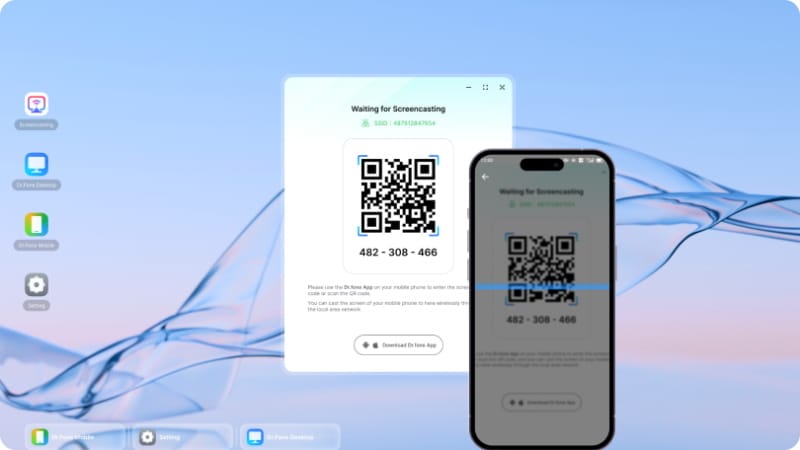
One efficient and user-friendly screen-mirroring app for Android and iPhone devices is the Wondershare Dr.Fone Air software. The app helps share screens from your mobile device and control how to view the content on the screen. Activating the function is not complex either here.
Price: Free
Pros:
- Completely share screens across different platforms easily.
- Control how to view content on the computer screen, like rotating, zooming in and out, etc.
- Quick, effortless mirroring process.
Cons:
- One cannot directly activate it through scanning.
How does it work?
- Visit the Fone Air official website on the computer. Launch the Dr.Fone Link app and connect your phone and computer using one WiFi network.
- Use the Dr.Fone Link app to scan the QR Code or enter the Cast Code to connect both devices.
- Screen mirroring will be when the two devices connect.
2. Screen Stream Mirroring
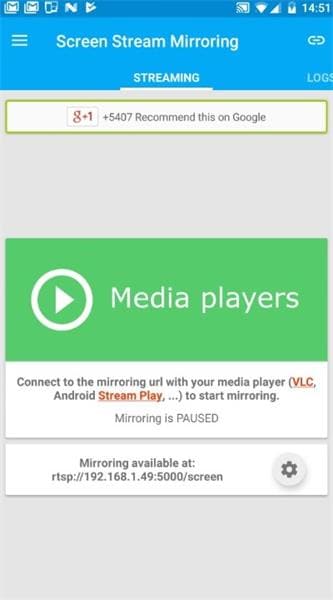
Use this screen mirroring app for Android mobile users to smoothly mirror the screen using tools and media players like XBMC/KODI, VLC, and more. The Screen Stream Mirroring Android app is efficient for browser-to-device screen sharing and broadcasting content easily across platforms. Also, get an on-screen stopper and timer to use while streaming.
Price: Free with in-app purchases.
Pros:
- Get the widget of the camera overlay during the streaming process.
- Easily screens share using web browsers.
- Possible to broadcast entertainment and game streams.
Cons:
- If you did not root the Vivo G2 device, a startup tool is needed for screen mirroring.
- Time limits are available for free plan users.
How does it work?
- Download the app. If no rooting has been done, activate the startup tool.
- Follow-on screen steps and then run it. Please switch off the Vivo G2 device and restart it again.
- The screen mirroring will activate.
3. LetsView

One of the best tools for Android users for a safe and effective screen mirroring process is the LetsView app. With this tool, one can easily screencast their phone content on external screens, like computers and television. Unlike some other options, you can do that without USB plugging here and activate via QR code scanning/PIN code.
Price: Free
Pros:
- Quick mirroring process.
- Works to cast Android screens on different branded television devices.
- Use one WiFi network to sync the Vivo G2 devices.
Cons:
- It does not work offline.
- Lagging issues can occur midway.
How does it work?
- Connect all devices to one WiFi network.
- Access the LetsView app. Find the Vivo G2 device to mirror.
- Choose the Vivo G2 device name that appears as “LetsView + device-name”. Upon selection, the mirroring process will occur successfully.
4. Pushbullet
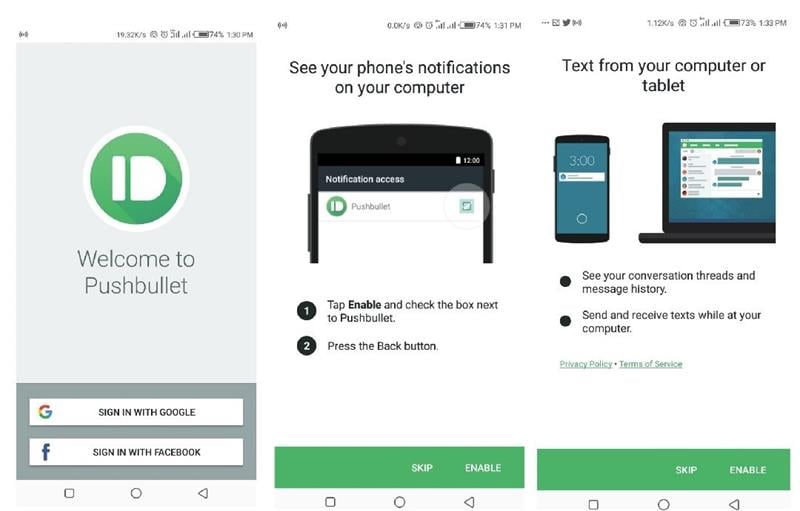
For easy phone screen sharing and mirroring usage, you can trust the Pushbullet software. The app allows smooth Android phone screencasting support to users and is simple to use for mirroring full-screen notifications, messages, and more.
Price: Free, Pro- USD 4.99 (monthly) pr USD 39.99 (yearly)
Pros:
- Easily use this to share links and media files.
- Chat with different users on mirrored screens on other devices.
- Get notifications regarding calls, texts, emails, etc.
Cons:
- The file-sending limit is capped at 25 MB.
- Action support for mirrored notifications is not supported for Free plan users.
How does it work?
- Download the app on your phone and activate it after registering with your account.
- Then, download the app on the desktop. Sign in when prompted.
- Link other devices and begin using the features.
5. TeamViewer
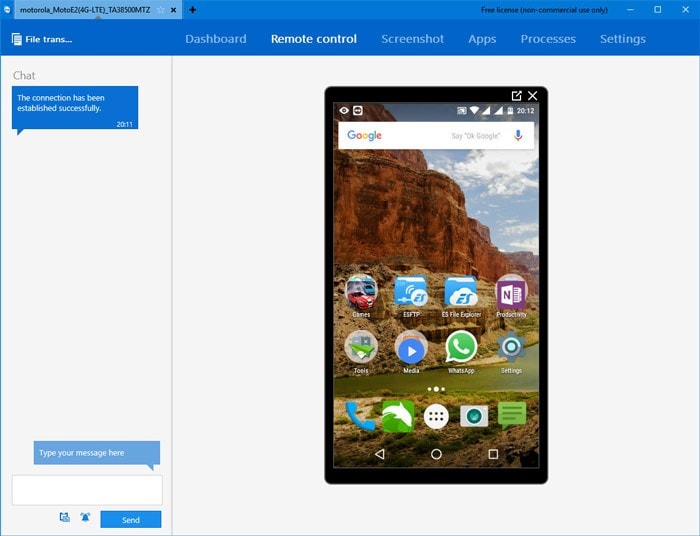
TeamViewer is another useful screen mirroring app for Android for improved management and control of professional processes from any device. With this effect, you can access different apps and files on mobile devices and computers, especially with screencasting functionality.
Price: Premium- USD 37.88/month, Corporate- USD 80.67/month
Pros:
- Strong 256-bit AES encryption is available.
- Works on different devices.
- No installation or registration is necessary.
Cons:
- Mainly useful for professional teams only, so features are suitable for a niche group of users.
- Mass deployment (MSI) is only available for Corporate plan users.
How does it work?
- Download and install the app on your computer and access the TeamViewer QuickSupport app on your phone. Get the displayed unique ID.
- Go to Start on Windows and launch the TeamViewer app.
- Add the unique ID > Connect to Partner > Allow.
- Tap on Start Now next.
6. Vysor
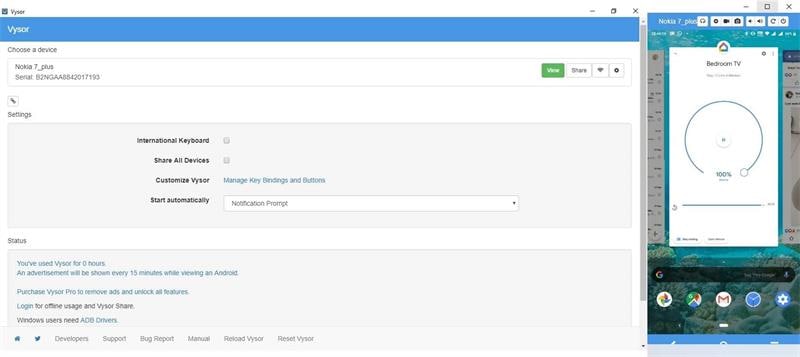
The following Android screen share app that we recommend is Vysor. The app is simple to navigate and comes with multi-platform compatibility support. You can choose which content to cast on the bigger screen through your Android phone and use a QR code/USB to connect and stream effortlessly.
Price: In-app purchase with cost starting at USD 2.50 per month.
Pros:
- Easily take screenshots of screened control.
- Activate and control your mirrored Android phone screen.
- Vysor Pro users get a variety of features, like full-screen support.
Cons:
- Free users do not get wireless support.
- Drag and drop functionality is not allowed for free plan users.
How does it work?
- Download the app on both mobile devices and computers separately and launch them.
- Use a USB Type C cable to connect both devices.
- Complete USB debugging processes via your browser by allowing Vysor access to it.
- Then, control the screen mirroring effect.
7. AirDroid Cast
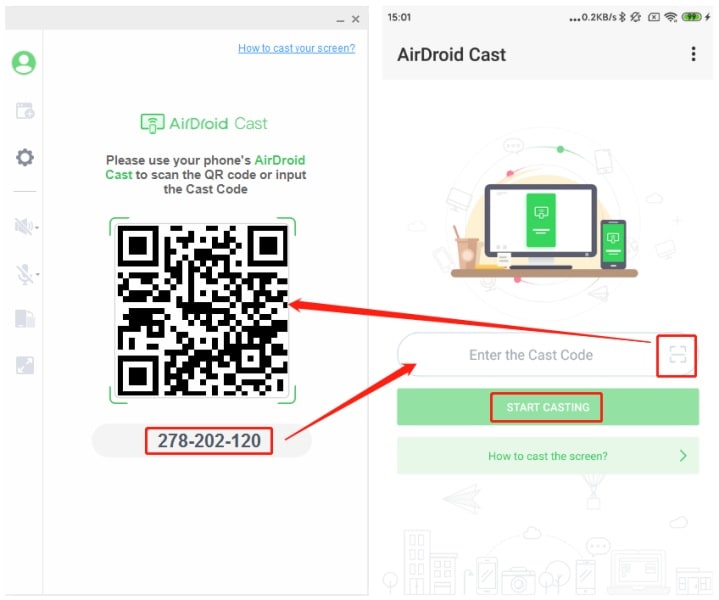
With AirDroid Cast, users can experience a high-quality screencasting experience from different phones or websites. Choose which channels and content you will have the chance to mirror on other screens easily. Various plans are available catering to different user needs.
Price: Free, Remote Casting- USD 2.49/month, Cast & Control- USD 3.49/month
Pros:
- Get two-way audio support.
- Quickly cast across different screens and devices.
- Use wireless cross-platform streaming functionality.
Cons:
- Only the Cast + Control plan version allows users the ability to control the cast Android screens.
- You can sync only one device with the Free plan.
How does it work?
- Download software on devices.
- Add the Cast code, Scan the QR code, or work with a USB cable to connect the two devices.
- The mirroring will activate on the second screen.
8. Cubetto
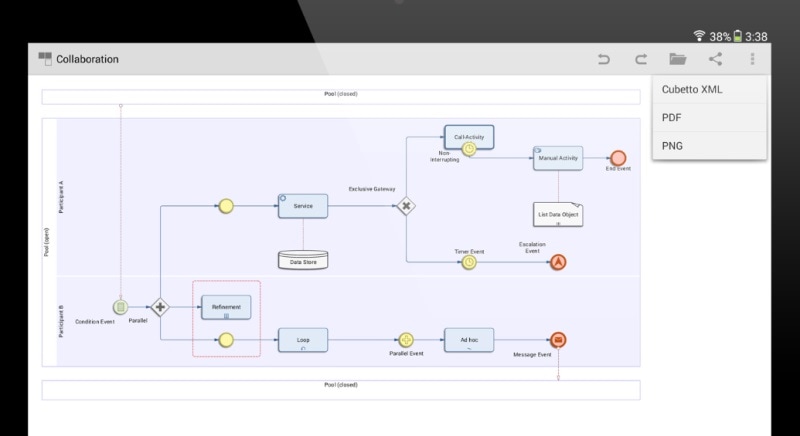
This app allows you to create and manage different diagram models and flowcharts for meetings. You will get auto-layout set up for all the diagrams you don’t have to handle manually. Prepare your models in different languages, and mirror them to varying devices.
Price: USD 20.17
Pros:
- Host meetings via screen mirroring on tablets and phones.
- Prepare and add customized attributes for all object types.
- Prepare project and diagram copies.
Cons:
- Valid for a niche group of users only.
- You cannot use this for personal content mirroring needs.
How does it work?
- Download, install, and launch the app on an Android phone.
- Use features available to monitor the auto-created flowcharts and diagrams.
- Export finished files in the supported formats or share them on other platforms via screen mirroring.
9. Unified Remote
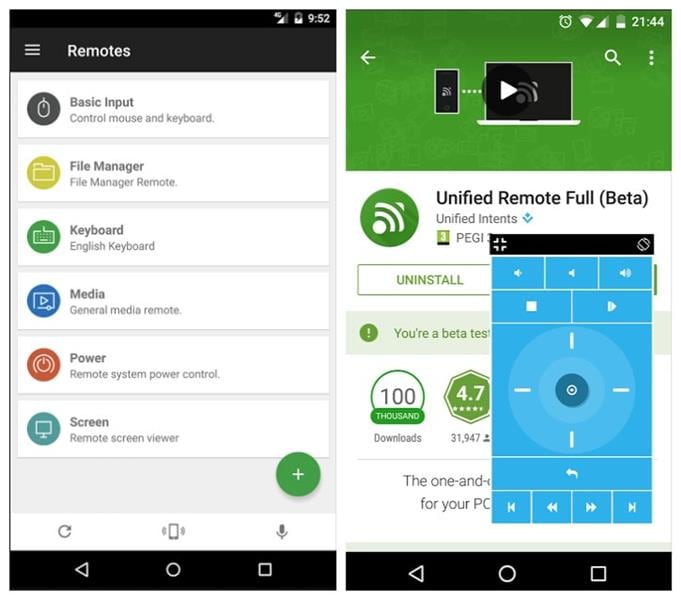
Unified Remote is one of the best screen share apps for Android users to try out. After activating this feature on your computer, you can mirror what’s in view on mobile devices. The mouse support here allows users to utilize the multi-touch or single-touch functionality for more accessible controls.
Price: In-app cost starts at USD 1.82.
Pros:
- Control different types of devices with varying remote devices.
- Easily control various media sources, like Netflix, iTunes, Spotify, etc.
- Simple screen mirroring process between computers and mobile phones.
Cons:
- You must invest in additional solutions for the mirroring process since it only works via a local network.
- Unable to control another Android phone from the first one.
How does it work?
- Download and activate the app on your mobile device.
- Install the Unified Remote Server on your computer.
- Connect to the server from your app on an Android phone via Bluetooth or WiFi. Screen mirroring will begin.
10. Roku
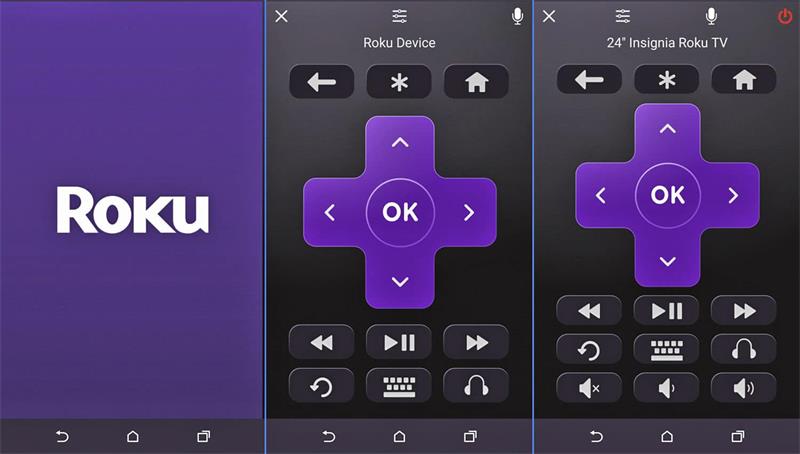
With this app, you can basically work it for streaming games and media from different apps and platforms. Choose between the various available channels, select the main content you wish to cast to another device, and continue using the tools available to control your actions.
Price: Starting at USD 29.99.
Pros:
- Stream different types of channels from global network providers and channels.
- Many languages are supported.
- Control and monitor your account and settings through the app.
Cons:
- You need to invest in additional devices.
- Slightly tricky for total beginners to handle at first.
How does it work?
- Power your Roku device up.
- Connect the Vivo G2 device to the active network connection you are using.
- Register for a Roku account. Then, activate the connection and begin screencasting on another device.
 TubeDigger - online video downloader from mostly any site
TubeDigger - online video downloader from mostly any site
11. Mobizen
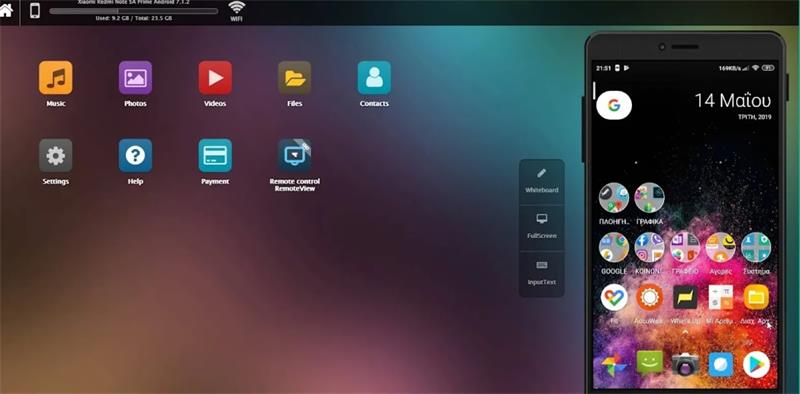
With Mobizen, it is straightforward to do quick and high-quality live broadcasts from a computer or mobile phone. You can mirror your videos through the Android device easily after activating this app.
Plus, for users creating game content to stream, this app helps do that. Connect to other significant sites like Twitch and YouTube for broadcast sharing and easily mirror your screen.
Price: Free, Standard- USD 12/month
Pros:
- Prepare broadcasts in real-time with many features for pre-production streaming.
- You can invite more participants easily for partnered podcasts.
- Add custom logos.
Cons:
- Limited types of content to edit and stream.
- QHD (2k) broadcasting is only available for paid plan users.
How does it work?
- Activate the Mobizen recorder function while playing a mobile game and record it.
- Download the file to the computer.
- Then, log in to the Mobizen site and prepare a scene with the recording.
- Live broadcast it to another platform.
12. MirrorGo

This particular mobile screen mirroring app for Android allows its users to easily mirror their Android phone to the computer screen via a WiFi connection. It is possible to record the Android phone and portray that across devices with MirrorGo. Plus, you can easily capture screenshots, transfer files, and more.
Price: Monthly- USD 19.95; Quarterly- USD 9.98/month; Annual- USD 3.33/month
Pros:
- High-quality screen capturing function in HD.
- You can easily sync your game data across platforms.
- Quickly recording the videos while streaming.
Cons:
- Not available for free.
- Only usable on 5 different devices per license.
How does it work?
- Sync the Android phone with your computer.
- Activate the USB debugging process on the mobile.
- Enable the mirroring process, and the screen will be cast on your computer quickly.
Conclusion
Indeed, all of the options mentioned in this list are commendable choices for screen mirroring. While each provides practical benefits and comes with some drawbacks, they are helpful to a specific group of users.
Different types of users can benefit from Dr.Fone Air - Online Screen Mirror, which makes it a suitable choice overall. However, consider their usability and functions before making your final decision.
Best 3 Vivo G2 Emulator for Mac to Run Your Wanted Android Apps
Mac OS, on the other hand, is a wonderful operating system used by Apple Inc. on it’s Mac PC and MacBook. It has a marvelous user interface and great features. It will be fantastic if we were able to use Android apps on Mac PC. Luckily, it is possible by using an emulator. In this article, we will learn about the five best Android Emulators for Mac.
Part 1. Why You Would Run Android Apps on Mac
- • To run around 1.2 million apps on Mac from Google Play Store.
- • To play tons of Android games on larger screen.
- • People, who spend a good amount of time in front of desktop, will find it more convenient if they were able to use apps like WeChat, WhatsApp, Viber, Line etc. on their Mac.
- • App developer can test their apps on the desktop before sending it to the Google Play Store for user reviewing.
- • Some Emulator supports battery and GPS widgets. So, developers can test their apps based on the battery performance and can also test how their apps will work on different geographical locations.
Part 2. Top 3 Android Emulator for Mac
1. BlueStacks
BlueStacks App Player is probably the most popular emulator for running Android apps on Mac. It is available for both Mac and Windows. It creates a virtual copy of Android OS apps on the guest OS. It uses the unique “LayerCake” technology that allows you to run android apps on your PC without any external Virtual Desktop Application. Once install user can enjoy Android games and apps such as News Feeds, Social Network on a large screen.
BlueStacks maintain an internal search manager that allows any apk, the package file format that is used to distribute and install application and middleware on any Android device, to install within it. It can be
Advantage
- • .apk files can be installed into BlueStacks from Mac simply by double clicking.
- • It can also sync between the apps on Mac and the android phone or tablet by installing BlueStacks Cloud Connect app on Android Device.
- • Apps can be launched directly from Mac dashboard.
- • No need to configure additional Internet connection as it automatically gets the Internet connection of host computer.
- • BlueStacks App Player is available for both Windows and Mac.
Disadvantage
- When running complex graphic apps it fails to respond to the input in a timely fashion.
- It does not provide any mechanism to uninstall cleanly from the host computer.
Download
- • It can be downloaded from the official website of BlueStacks . It is absolutely free.
How to use
Download BlueStacks for Mac OS X from the official website of BlueStacks and install it like any other software on your PC. Once installed, it will boot up to its Home Screen. From there you can find the installed apps, find new apps in the “Top Charts”, search apps, play games and change settings. Mouse will be the basic touch controller. To access Google Play you will have to associate a Google Account with BlueStacks.
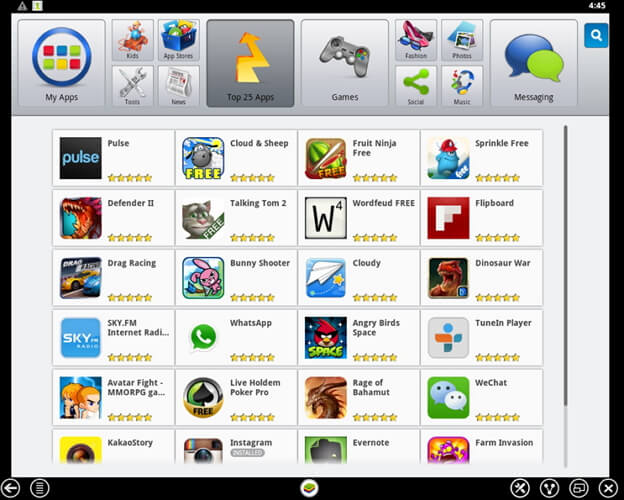
2. Genymotion
Genymotion is a fast and wonderful third party emulator that can be used to create a virtual environment for Android. It is the fastest Android emulator on the earth. It can be used to develop, test and run Android apps on Mac PC. It is available for Windows, Mac, and Linux machine. It is easy to install and can create a customized android device. You can start multiple virtual devices at the same time. It has the pixel perfect functionality so you can be precise to your UI development. By using the OpenGL acceleration it can achieve the best 3D performance. It directly commands the virtual devices sensors with Genymotion sensors. It is evolution of the Android open source project and already trusted by about 300,000 developers around the globe.
Advantage
- • Best 3D performance is achieved through OpenGL acceleration.
- • Support full screen option.
- • Can start multiple virtual devices at the same time.
- • Fully compatible with ADB.
- • Available for Mac, Windows and Linux machine.
Disadvantage
- • Require virtual Box to run Genymotion.
- • Cannot deploy Android machine offline.
Download
- Genymotion can be downloaded from the official website of Genymotion. The latest version of Genymotion is 2.2.2. You have to choose a package that meets your requirements.
How to use
- 1. Download Genymotion. You have to create an account to download it.
- 2. Open the .dmg installer. It will also install Oracle VM Virtual Box on your computer.
- 3. Move the Genymotion and Genymotion Shell to application directory.
- 4. Click the icon from Application directory and the following window will appear.
- 5. To add virtual device click on the add button.
- 6. Click on the connect button.
- 7. Enter your user name and password to connect to the Genymotion Cloud and click on the connect button. After connecting with the Genymotion cloud the following screen will appear.
- 8. Select a virtual machine and click on Next.
- 9. Give a name for the Virtual machine like below and click on Next.
- 10. Your virtual device will be now be downloaded and deployed. Click on the Finish button after successful deployment of your virtual machine.
- 11. Click on the Play button to start the new virtual machine and enjoy.

3. Andy
Andy is an open source emulator that allows developers and users to enjoy more robust apps, to experience them in multiple device environments, and to stop being constraint by the limits of device storage, screen size or separate OS. User can update their Android through Andy. It provides seamless sync between desktop and mobile device. User can use their phone as joystick while playing games.
Advantage
- • It provides a seamless sync between desktop and mobile device.
- • Enable Android OS update.
- • Enable app download from any desktop browser to Andy OS.
- • Phones can be used as joystick while playing games.
- • Unlimited storage expansion.
Disadvantage
- • Increase CPU usage.
- • Consumes a lot of physical memory.
Download
- • You can download Andy from <www.andyroid.net>.
How to Use
- 1. Download and install Andy.
- 2. Launch Andy. It will take about a minute to boot and then it should see a welcome screen.
- 3. Sign into your Google Account and complete the rest of the setup screen. You will be asked to provide your Google Account Information to 1ClickSync, the app that let’s you sync between Andy and the mobile device

- Title: In 2024, How To Do Vivo G2 Screen Sharing | Dr.fone
- Author: Seraphina
- Created at : 2024-07-26 08:25:20
- Updated at : 2024-07-27 08:25:20
- Link: https://screen-mirror.techidaily.com/in-2024-how-to-do-vivo-g2-screen-sharing-drfone-by-drfone-android/
- License: This work is licensed under CC BY-NC-SA 4.0.



 LYRX is an easy-to-use karaoke software with the professional features karaoke hosts need to perform with precision. LYRX is karaoke show hosting software that supports all standard karaoke file types as well as HD video formats, and it’s truly fun to use.
LYRX is an easy-to-use karaoke software with the professional features karaoke hosts need to perform with precision. LYRX is karaoke show hosting software that supports all standard karaoke file types as well as HD video formats, and it’s truly fun to use.





 Forex Robotron Basic Package
Forex Robotron Basic Package OtsAV Radio Webcaster
OtsAV Radio Webcaster
